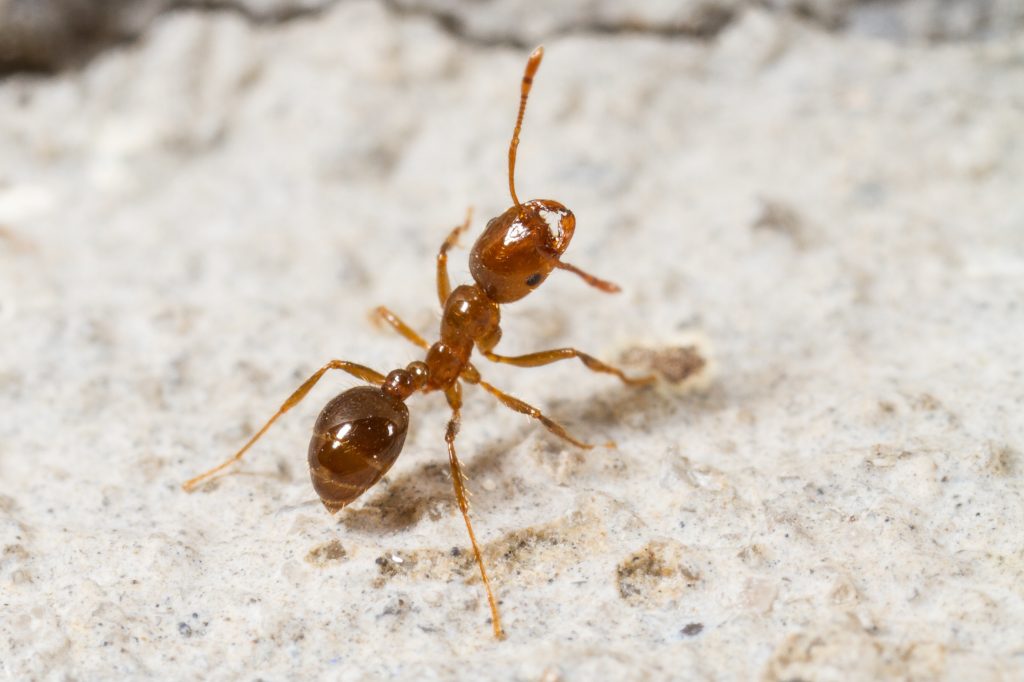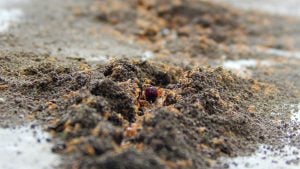
Red Imported Fire Ant, Solenopsis invicta
The Red Imported Fire Ant, commonly referred to as RIFA, is a serious exotic species that could impact Australia’s natural environment, the economy and our lifestyle. RIFA, as their name suggests, can inflict a painful, ‘fiery’ sting, which can last for up to a week and cause itchy pustules to form. Some people also have dangerous allergic reactions to stings and will need to seek immediate medical help.
RIFA can have serious ecological and environmental impacts. RIFA are known to form super colonies with multiple queens which means they can spread rapidly affecting entire ecosystems. RIFA are omnivorous and opportunistic and prey on plants, invertebrates and vertebrates.
They are known to feed on small fauna and can cause significant damage to grazing animals that disturb their nests. Native Australian fauna are at risk of being preyed upon, outcompeted by RIFA or face complete extinction. They are also known to feed on seeds, which may cause irreversible changes to ecosystems.
If introduced, RIFA has the potential to impact agricultural businesses, tourism, sporting fields, and golf courses, which could have a wider economic impact. Similarly, public open spaces such as parks and playgrounds infested with RIFA could be deemed unusable, causing impacts to lifestyle.
RIFA is native to South America but has been found in the United States, China, Taiwan, Japan and the Philippines and Australia.
Finding its way to Australia
RIFA was detected at the Port of Brisbane and in the Brisbane suburb of Richlands in 2001. Over several years it continued to spread to Ipswich, Logan, Redlands, Scenic Rim, Gold Coast and Lockyer Valley. RIFA has caused problems for the agriculture industry in those regions, as well as the wider community.
After careful consideration of the degree to which the pest had spread and the damage that it had already caused, the Australian state and federal governments determined that eradicating RIFA from Queensland was possible. This program, called the National Red Imported Fire Ant Eradication Program, is still in place. Although RIFA is yet to be eradicated from Brisbane, the program has prevented further spread in Queensland and its establishment in other Australian states. However, RIFA is a highly invasive species and has been detected (and subsequently eradicated) in Port Botany, Sydney (2014) and Fremantle, WA (2019). Therefore, while RIFA is not known to be present in Melbourne, it could arrive in shipping containers, infested machinery and equipment, and materials such as pot plants, soil, mulch and timber from interstate. As such, it is important to know what RIFA looks like and to keep an eye out to help prevent its spread.
What am I looking for?
RIFAs are very small, ranging from 2 – 6 mm and are reddish-brown in colour with dark abdomens.
As they are small, difficult to spot and identify from other species of ant, it is easier to find them by looking for the nest. In urban environments, nests are commonly found in gardens, lawns and adjacent to footpaths, taps and other items of urban architecture.
A RIFA nest looks like a mound of loose dirt, has no visible entry holes, and can reach 40 cm high. If you see something like this in your backyard or in the neighbourhood, do not disturb it. When a nest is disturbed RIFA will swarm out immediately and attack.
In rural environments, RIFA may also form nests in piles of organic matter, on turf, under timber or pallets, at the edge of dams, and along fence lines.

Anthill with red fire ants
What can I do to help?
We can all help by looking out for RIFA or RIFA nests and knowing how to report them.
If you think you have found a RIFA nest in your garden, property, or local area, do not disturb the nest. Pick up the phone and call the Exotic Plant Pest Hotline on 1800 084 881. You’ll be directed to the relevant Department of Primary Industries.
Alternatively, take a photo and upload it to the MyPestGuide Reporter website or app. If you live in Melbourne, your report will go directly to Agriculture Victoria’s team of entomologists.
With your help, we can keep RIFA out of Victoria and provide a safer, healthier environment for all Victorians.
If you are bitten by an ant, and are experiencing trouble with breathing, dizziness, swelling of the tongue, nausea or other severe symptoms, please seek medical help immediately.
Find out more:
Take a look at these videos from Biosecurity Queensland on identifying fire ants and why we need to put a stop to them in Australia.
National Pest and Disease Outbreaks keep up to date on the current situation of Red Imported Fire Ants and Queensland Government has further information on the impacts of this pest.
Read about further about the stings of Red Imported Fire Ants on healthline.
Don’t forget to check out our Pest Warrior comic and fill out our Target Pest Activity Book.
